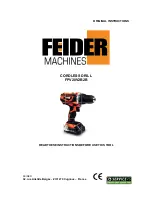
BEFORE CONNECTING TO CCTV CAMERAS OR DEVICES:
•
Check the DIP switch setting to ensure correct voltage (6VDC, 12VDC, or 24VDC).
•
With power turned on, check the wires connected to each terminal pair to ensure correct voltage.
EVP-224D4-P9Q Shown
•
Enclosure:
•
Heavy-duty steel case to protect the power connections
•
Removable steel cover for easy access
•
Ventilation holes to prevent heat build-up
•
Dimensions - 10” x 7.75” x 3.5” (254 x 196 x 89 mm)
[12.15" x 12.25" x 3.6" (308 x 311 x 91 mm) for
EVP-224D6P16Q]
•
Knock-out on the cover for optional cam lock
Specifications:
•
Adjustable VDC outputs:
•
Output voltage adjustable with potentiometer to
compensate for voltage drop.
•
Each individually fused (PTC**-type fuses)
•
Output fuses rated 1.1 Amps @ 250VAC
•
Individual red status indicator LED for each output
•
Main power switch to turn on/off power to outputs
•
Power:
•
Input:240VAC; Output: 6/12/24VDC
•
Main fuse rated 5.0 Amps @ 250VAC ( 3Amps. for
EVP-224D2-P4Q)
•
Spare fuse included
**Positive Temperature Coefficient
Installation Manual
ENFORCER
®
EVP-224D2-P4Q
(4 Outputs @ 6/12/24VDC, 2 Amps*)
EVP-224D4-P9Q
(9 Outputs @ 6/12/24VDC, 4 Amps*)
EVP-224D6P16Q
(16 Outputs
@
6/12/24VDC, 6 Amps*)
DC-Power Supplies for CCTV Cameras and Accessories
* Total max. supply current at 12VDC, each channel output is fused at 1.1 Amp.
Knock-out for
optional cam lock
Ventilation
Holes
FIG. 1:
Knockouts
for running cables
Cable & Power
Knock-outs
What it is:
This ENFORCER CCTV power supply centralizes the CCTV system's power
input, power transformer, DC regulator, and independently-fused power
outputs in one heavy-duty, easy-to-install enclosure.
Note before installation:
•
DOUBLE-CHECK VOLTAGE SETTINGS BEFORE CONNECTING THE CAMERAS.
•
Indoor use only - Do not mount where exposed to rain or moisture.
•
For professional installation only.
•
Installation must conform to all local codes.
Installation:
1. Find a good location. Mount the enclosure out of sight and protected from
moisture, but where an authorized service person can have access.
NOTE:
Make sure the space where the enclosure is to be mounted has
adequate ventilation. Otherwise, heat buildup inside the enclosure could
damage the electronic parts or cause the PTC fuses to trip needlessly.
2. Locate the enclosure mounting holes. Using the enclosure as a template,*
mark the location of one of the two upper screws on the wall with a pencil.
Fasten one
5
/
32
"
x 1" (4 x 26mm) screw (not included) until the gap
between the wall and the screw head is approximately 1/4" (6mm).
Hang the enclosure on this screw and adjust the proper angle of the
enclosure. Repeat with the second screw. Then mark up and securely
fasten the enclosure with all four screws.
*Or mark up a paper template from the enclosure and drill after taping the
template in correct position.
3. Determine how the main power line and CCTV camera cables will be run --
The enclosure has knock-outs on the side, top, bottom, and rear panels for
running cables. Punch the appropriate knock-outs. See Fig. 1.
NOTE:
If cables are run out of the side, top, or bottom panels, protect with
an electrical conduit of not more than 1" outside diameter. Wires running
inside the electrical conduit must not be too tight.
4. To connect the main power cord to the small white terminal block, follow
the wire color indicated on the "NEA" label that is placed beside the
terminal block (i.e., white wire on top, green wire to the middle, and black
wire to the bottom of the terminal block, see Fig. 2).
Use the provided nut and cable clamp to fasten the power cord onto the
metal enclosure in the location shown on Fig. 2 if necessary. A plastic
snap bushing is also provided for the power cord hole.
Note: Products with model number that ends with "Q" or have a green “Q” sticker represents RoHS compliant products.




















